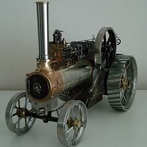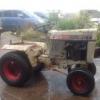-
Content Count
854 -
Joined
-
Last visited
-
Days Won
35
Reputation Activity
-
 Wristpin got a reaction from Lauren1985 in Hayterette push on
Wristpin got a reaction from Lauren1985 in Hayterette push on
If you can find the appropriate BS manual* it shows how to reseat that jet, but the weapon of choice is a Briggs dip stick tube. The slightly chamfered end that pushes into the plastic seal in the sump of its intended use, pushes against the steel “ bellville” washer of the jet assembly and seats it into the carb.
* Single cylinder L head post 1981. Page 23. Publication 270962-12/03
-
 Wristpin got a reaction from Anglo Traction in Pto clutch linings
Wristpin got a reaction from Anglo Traction in Pto clutch linings
Loctite do a useful two part adhesive called Multibond. Quick curing. I’ve used it successfully to re- attache Hayer Osprey and 21 clutch linings and other similar jobs.
-
 Wristpin got a reaction from ranger in Pto clutch linings
Wristpin got a reaction from ranger in Pto clutch linings
Loctite do a useful two part adhesive called Multibond. Quick curing. I’ve used it successfully to re- attache Hayer Osprey and 21 clutch linings and other similar jobs.
-
 Wristpin got a reaction from riber3 in Hayter Osprey
Wristpin got a reaction from riber3 in Hayter Osprey
That’s a Magnetron ( electronic, no points) coil. Setting the air gap by the book - turn the flywheel to move the magnets away from the coil.Loosen the coil bolts and pull it away from the flywheel, tighten one. Turn the flywheel so that the magnets are under the coil armature legs. Insert your non magnetic gauge between the coil legs and the flywheel. Loosen th holding bolt so that the magnets pull the coil to the flywheel. Tighten both bolts and rotate the flywheel while pulling the gauge out.
The gauge. I remember that instruction sheet supplied with new genuine coils can be used as a gauge. I use a strip of plastic cut from a milk carton.
-
 Wristpin got a reaction from Steve in France in Hayter Osprey
Wristpin got a reaction from Steve in France in Hayter Osprey
That’s a Magnetron ( electronic, no points) coil. Setting the air gap by the book - turn the flywheel to move the magnets away from the coil.Loosen the coil bolts and pull it away from the flywheel, tighten one. Turn the flywheel so that the magnets are under the coil armature legs. Insert your non magnetic gauge between the coil legs and the flywheel. Loosen th holding bolt so that the magnets pull the coil to the flywheel. Tighten both bolts and rotate the flywheel while pulling the gauge out.
The gauge. I remember that instruction sheet supplied with new genuine coils can be used as a gauge. I use a strip of plastic cut from a milk carton.
-
 Wristpin got a reaction from Triumph66 in Bolens deck illustrated parts list
Wristpin got a reaction from Triumph66 in Bolens deck illustrated parts list
I have a tatty but legible four page parts list for a Model 18418 38"Deck , types 01,02,03. serial numbers 0400101 thru to 0599999
Going free, pm me. First one gets the original , then copies.
Angus
-
 Wristpin got a reaction from Stormin in Meetens
Wristpin got a reaction from Stormin in Meetens
Dealt with Meetens since the late seventies when they were in Coombe Lane , Wimbledon; for parts and re-bores etc. Always good service and advice. In those days the phone was often answered by the redoubtable Miss Childs who was the proverbial encyclopaedia of all things Villiers . Let on that you thought that you should be talking to a chap and your card was very politely marked.
A sad sign of the passing years. Best wishes to Paul.
PS. Should add that I’ve heard that L&S Engineers are taking over Meeten’s stock.
-
 Wristpin got a reaction from nigel in Meetens
Wristpin got a reaction from nigel in Meetens
Dealt with Meetens since the late seventies when they were in Coombe Lane , Wimbledon; for parts and re-bores etc. Always good service and advice. In those days the phone was often answered by the redoubtable Miss Childs who was the proverbial encyclopaedia of all things Villiers . Let on that you thought that you should be talking to a chap and your card was very politely marked.
A sad sign of the passing years. Best wishes to Paul.
PS. Should add that I’ve heard that L&S Engineers are taking over Meeten’s stock.
-

-
 Wristpin reacted to Joseph in Bolens large frame snow/dirt blade replica
Wristpin reacted to Joseph in Bolens large frame snow/dirt blade replica
A bit more progress on the snow plough. In this video we finish making the clevis forks and get the hydraulic cylinder cleaned up and painted with primer. I was very pleased with how the clevis forks turned out.
-
 Wristpin reacted to Aiberdonian in Triumph Gloria - a sympathetic restoration
Wristpin reacted to Aiberdonian in Triumph Gloria - a sympathetic restoration
The engine is a 4 cylinder 10.8 HP (1232 cc) overhead inlet, side exhaust Coventry Climax made under licence by Triumph and during the late 1980's would overheat and boil after about 8 miles.
It was either rubbish around the exhaust ports in the block or a blocked radiator so radiator was removed followed by the engine which was partially dismantled short block status.
Over the years I had read in the club magazine about the amount of rust and debris that had been found in similar engines along with aluminium corrosion - the water inlet confirmed this when removed, the rear port was completely blocked and the top flange broke off in the process
The cylinder head and studs were removed as were the sump and its studs before all the core plugs were knocked out.
The amount of rust and rubbish was horrendous which explained the overheating problem, the block was probed and poked with a variety of screwdrivers chisels and lengths of bar and power washed until all the areas around the cylinders and exhaust ports were clear.
The radiator had always had a greasy film around the filler which I think was due to pumping water pump grease into the pump bearings to stop it leaking so much but what to use to try cleaning it. I was wary of using some of the chemical cleaners on an 80 year old brass cored radiator and after some research found that a lot of people in the US used their equivalent of Fairy Liquid to clean out oil contaminated radiators on old trucks. An old zinc bath, my submersible pump and warm water with plenty Fairy Liquid was connected to the radiator and I reverse flushed it several times and then left it overnight full of the mixture and then flushed it a few times next day. There was no restriction to flow and the greasy film had disappeared so it was back to the engine,
I don't think the engine had done more than 1,000 miles since being bored and having new bearings in 1963 and after checking the bores and a couple of the big ends didn't think it was necessary to strip it down any further. A couple of the cylinder head stud threads in the block were a bit suspect so I retapped as far as I could and sourced some new studs, fitted new exhaust valve guides, ground in the valves, treated it to a new timing chain, selected the best cam follower housings and followers from spares that had been removed from a scrap 6 cylinder engine from a 2 door Gloria Coupe that my father had broken for spares in the 1950's (wish we still had that one) and fitted a set of new brass core plugs.
The engine was re-assembled with new water inlet and new water pump
The clutch had some surface rust on the flywheel and pressure plate and was easily cleaned up with emery cloth before being bolted back on and the engine was installed with new rubber engine mounts - the old ones were past their best
The carburettors were then fitted - there is a small side draught and a larger down draught working on the same principle as the progressive twin choke weber where the small one opens to half throttle and then opens the large one until they are both fully open as this is a Gloria Vitesse engine.
New oil, plugs, plug wires, points, condenser filled with water and some petrol in the tank it fired up and ran with good oil pressure, it did require a bit of tweaking of the jets to get it running reasonably well and that is how it ran last year but the more miles it did the smokier the exhaust became until it was becoming really bad when hot. The last thing I needed was some tree-hugging do-gooder phoning the police complaining about an old car belching out smoke - I had already a run in with Police Scotland about carrying a shotgun on the roadside a couple of years ago. I also had water leaking up the cylinder head studs and when tightening them a little further felt a couple of them let go in the block
This year I took the engine out again thinking that the piston rings were rusted and allowing oil up the bores but when all stripped down they were in perfect condition and discovered that the inlet valve guides were badly worn. They had felt quite good last year and I think they had been gummed up with oily carbon that hadn't come off when I power washed it but as it ran more the new oil had slowly washed it away - 4 new inlet guides duly sourced and fitted.
The cylinder head studs were a different story as the threads in the block were stripped on two of them and another three were suspect. A club member had repaired his by making some 1/2" UNF OD inserts and tapping them 3/8" BSF for the studs but he had the benefit of access to a milling machine and I don't so I needed a different solution. By chance I had some Jaguar 3.8 waisted cylinder head studs with 7/16" UNF threads and 3/8" dia waist section.
I made a steel block with 3 different ID sized inserts that I could clamp on to the block face - a 3/8" one to line it up using original stud, second one for 7/16" tapping drill and a third one to line up the 7/16" UNF tap as the hole was threaded. The Jaguar studs were cut and a 3/8" BSF thread cut on the waisted section
The engine was assembled once again with a thread sealant applied to the cylinder head studs this time to stop any water coming up the studs.
Another change I made was to fit a single downdraught Zenith carb as the throttle spindles on the SU's are very worn and I couldn't get the engine to run properly, it is now a lot more driveable with just a slight hesitation on take off but isn't a problem on the road.
I may try to refurbish the SU's at some point to return it to Vitesse specification.
-
 Wristpin got a reaction from Anglo Traction in E tank house keeping!
Wristpin got a reaction from Anglo Traction in E tank house keeping!
Its that time of year to do a bit of maintenance on the E tank as all the time its quietly removing rust the anodes are being eaten away - so today was the day.
As you will see, they've been hard at work and it was time to put some old gang mower and triple bottom blades to good use.
-
 Wristpin got a reaction from Stormin in E tank house keeping!
Wristpin got a reaction from Stormin in E tank house keeping!
Its that time of year to do a bit of maintenance on the E tank as all the time its quietly removing rust the anodes are being eaten away - so today was the day.
As you will see, they've been hard at work and it was time to put some old gang mower and triple bottom blades to good use.
-
 Wristpin got a reaction from Rayp in E tank house keeping!
Wristpin got a reaction from Rayp in E tank house keeping!
Its that time of year to do a bit of maintenance on the E tank as all the time its quietly removing rust the anodes are being eaten away - so today was the day.
As you will see, they've been hard at work and it was time to put some old gang mower and triple bottom blades to good use.
-
 Wristpin got a reaction from nigel in E tank house keeping!
Wristpin got a reaction from nigel in E tank house keeping!
Its that time of year to do a bit of maintenance on the E tank as all the time its quietly removing rust the anodes are being eaten away - so today was the day.
As you will see, they've been hard at work and it was time to put some old gang mower and triple bottom blades to good use.
-
 Wristpin got a reaction from Rayp in Stihl Blower
Wristpin got a reaction from Rayp in Stihl Blower
Don’t think that you will find a float as it will probably have a “cube carb” with a needle valve operated by a diaphragm. If you are lucky it will respond to a good clean to remove gum and stale fuel - best done in an ultra sonic tank. . Not so lucky the diaphragms will have hardened or split. Worst of all it won’t respond and will need a replacement carb. Dare I say that a Chinese copy carb will cost far less than even a genuine diaphragm and gasket set. Have a look at Garden Hire Spares.
-
 Wristpin got a reaction from nigel in Aspera points gap.
Wristpin got a reaction from nigel in Aspera points gap.
Unlikely to be a timing issue as it has a keyed flywheel. Even if someone has messed with the stator positioning in its slots , mid way should be ok for test purposes. If it has a kill wire going to a kill switch on the throttle / Governor plate, disconnect it. Also, are the points spotlessly clean? After that, you need to find someone who can test the coil and condenser.
-
 Wristpin got a reaction from Stormin in Aspera points gap.
Wristpin got a reaction from Stormin in Aspera points gap.
Usually 20thou” . Often stamped into the points cover.
-
 Wristpin reacted to Aiberdonian in Triumph Gloria - a sympathetic restoration
Wristpin reacted to Aiberdonian in Triumph Gloria - a sympathetic restoration
Nae happy !! Doing a bit more last night and just about to load the last photo and internet crashes and lost the lot.
With all the tools and raw materials gathered it was time to start dismantling, the chassis was levelled on two wooden blocks and rear bodywork supported by two adjustable scaffold feet and some aluminium tube under the boot top rail, wheels were removed, rear wings removed and all the interior trim from the back seat rearwards.
It was evident that the rear body section was sinking causing the sides of the rear wings to bow out and the front of the doors to rise above the front bulkhead level.
On the offside you can see the wooden chassis mount is tilted along with a broken bracket and a makeshift repair with some sheet steel.
The nearside gives a better view of how it is constructed with the chassis attachment plate half lap jointed to the cross member, a fairly solid support block attached to a length of angle iron bolted to the steel inner wheel arch. The boot hinge is bolted up through the cross member with one bolt coming through a steel bracket coming round and up along the lower wheel arch frame which is again attached to the back of the support block.
80 year old wood screws are not the easiest of things to remove especially in such confined spaces but using small cutting discs in the dremel the slots were tidied up and with a selection of different sized flat screwdriver bits and various ratchets and sockets to fit all but two came out and I was lucky enough to have space to drill them out with a right angled drill and some short stumpy drill bits that I had bought for this job some time earlier.
The bolts were also dispatched using the dremel and cutting discs but it was all too easy to shatter them and quite a number were used.
I had to cut the crossmember to ease removal of all the bits but was still able to measure them and get dimensions for the new pieces, the chassis mounts and support blocks along with the crossmember were relatively easy to make as they were all straight sided, the lower wheel arch extension needed to be curved but after some trial and error I worked out the radius and used the router to form this piece.
By fixing the workpiece and pivot block to a 8 x 4 x 3/4" sheet of plywood the radius was set and the inner radius cut then adjusting the threaded rod by the required thickness the outer radius was machined - a lot of playing about but it worked out OK.
Behind the boot hinge bracket there was some evidence of a solid piece connecting the boot side rail, another body rail and the lower wheelarch extension which had been screwed from the outside before the aluminium had been formed around it, I managed to make a couple of pieces that would fit to all three wooden rails but just could not get the correct profile to fit the body.
After two attempts and even trying some modelling clay I finally managed to get the correct profile by using one of my trial pieces, covering it in a good layer of body filler, covering it with a polythene bag and gently pressing it in to position.Once set I was able to use a profile gauge every 1/4" along the piece to copy to the new one.
With all the new pieces made and trial fitted, broken bracket welded back together, pilot holes for the screws were marked and drilled and holes for the bolts drilled, final assembly took place with all pieces glued and screwed together.
The rear body was now solid and firmly attached to the chassis for the first time in over sixty years.
The fun really begins now.
-
 Wristpin got a reaction from Veg Grower in Advice required for Howard 300 clutch Brake
Wristpin got a reaction from Veg Grower in Advice required for Howard 300 clutch Brake
Howard 350 cone clutch brake0001.pdf
I did hope that a Howard expert would come to your rescue. I’ve never owned a 300/350 but have worked on a few. A while back there was a clutch thread on another forum
https://www.vhgmc.co.uk/forums/topic/howard-300-rotovator/
But I’m not sure that there is anything useful there for you.
I will scan and post an image of the cone clutch set up with a brake. Having worked on a few over the years and being kind I would call the brake a bit of a lash up . Unless someone tells me that I’ve been doing it all incorrectly it seems a very fine line between disengaging the clutch and the application of the brake on the driven ( female) cone - needing frequent adjustment. It is also important that the thrust bearing is in good condition and not partially seized.
Image to follow.
https://myoldmachine.com/applications/core/interface/file/attachment.php?id=40650
-
 Wristpin got a reaction from Stormin in Advice required for Howard 300 clutch Brake
Wristpin got a reaction from Stormin in Advice required for Howard 300 clutch Brake
Howard 350 cone clutch brake0001.pdf
I did hope that a Howard expert would come to your rescue. I’ve never owned a 300/350 but have worked on a few. A while back there was a clutch thread on another forum
https://www.vhgmc.co.uk/forums/topic/howard-300-rotovator/
But I’m not sure that there is anything useful there for you.
I will scan and post an image of the cone clutch set up with a brake. Having worked on a few over the years and being kind I would call the brake a bit of a lash up . Unless someone tells me that I’ve been doing it all incorrectly it seems a very fine line between disengaging the clutch and the application of the brake on the driven ( female) cone - needing frequent adjustment. It is also important that the thrust bearing is in good condition and not partially seized.
Image to follow.
https://myoldmachine.com/applications/core/interface/file/attachment.php?id=40650
-
 Wristpin reacted to Joseph in Bolens large frame snow/dirt blade replica
Wristpin reacted to Joseph in Bolens large frame snow/dirt blade replica
It has been a while since we have have posted. We have started a new project which is to build a replica of the Bolens large frame snow/dirt blade, Bolens part number 18085. The simple rule is that it is not allowed to snow until we are finished
This is a very rare attachment and realistically our only chance of owning one is to make a replica. Chris Stoneman recently purchased one of the few know to exisit in the UK and we picked it up for him which gave us the chance to take lots of measurements.
Chris's blade did not come with the lift push rods and we need some help with those. In the manual, it says that the distance between the centre line of the holes in the clevis rodes is 26-1/2" which gives a bit of an insight into the lengths of the rods. We did some searching on the Internet and that highlighted that the push rods are 20" long for the early large frames and 22-1/2" long for the HT's. We will be fitting this to our HT20 which suggests we need to make 22-1/2" rods. If someone has this attachement I would be grateful if you can measure the length of the push rods and confirm if they are 22-1/2". Also it would be helpful to know the length of the threaded part of the rod. Thanks in advance.
At the moment we get one tractor day a week so this project will take a while but it should be fun and I hope you follow along. I am making some notes of the work we are doing and making videos of the progress. In today's video I cover the preperation and cutting of the metal.
-
 Wristpin got a reaction from Triumph66 in Allen Lawn Ranger
Wristpin got a reaction from Triumph66 in Allen Lawn Ranger
Well, there was life pre Internet . My business career started with paper manuals, then microfiche, CDs, DVDs, downloads and now it’s “all “ in the cloud ; but only if someone has put it there. It’s a good job that some of us have hung on to the paper manuals - but not for much longer!
-
 Wristpin got a reaction from Lincoln John in Allen Lawn Ranger
Wristpin got a reaction from Lincoln John in Allen Lawn Ranger
Sorry, didn't realise that this thread was still live.
Main drive SPA 1900
Secondary SPA800
Front units SPA850
Rear unit SPA1120
I don't remember the belts being difficult to fit, in fact we fitted stronger springs for one customer who always tried to cut too much at a time. Little and often was the order of the day. The Lawn Ranger was replaced by the Turf Trooper which addressed most of the short comings of the original machines.
-
 Wristpin got a reaction from Stormin in Will they be big enough?
Wristpin got a reaction from Stormin in Will they be big enough?
Very impressive but bear in mind the old adage that all the available kit (and clutter) will eventually fill all the available space!












